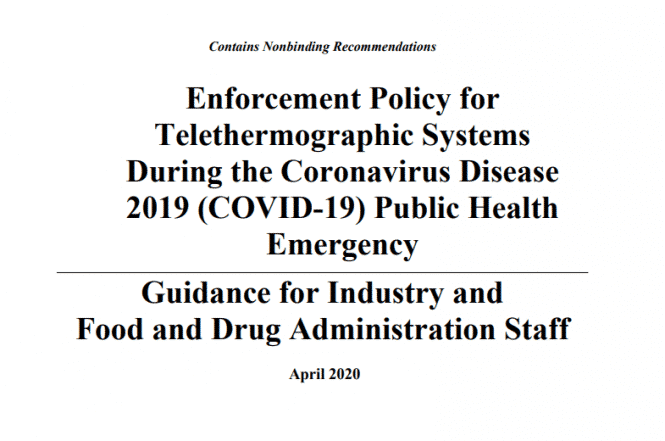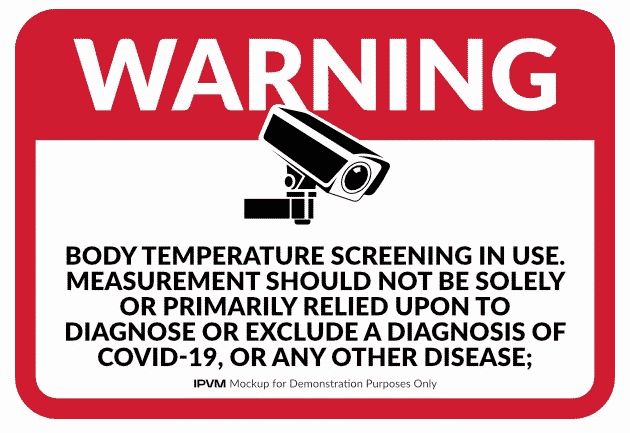
With regard to the FDA, they issued a statement in April 2020 that they “don’t intend to object” to those selling such cameras without FDA 510(k) clearance and the reason why:
Many of the approved manufacturers (14) are at a disadvantage in the near term.
For reference here is the actual FDA Enforcement Letter dated April 20. FDA COVID-19-Thermography-Devices-Guidance_0_0
Here is a point by point explanation of FDA statement.
FDA Reasoning: Fighting Shortage
The FDA said it is doing this as it wants to address the shortage of such devices
Policy Only Temporary
The FDA emphasized that this guidance is temporary:
Fever Cams Considered Medical Devices
Despite some companies falsely claiming their fever cameras are somehow not medical devices, in this guidance, the FDA clearly states that it does consider these products medical devices and under its regulatory purview
“Undue Risk”
However, the FDA emphasized, in the same guidance, that this only holds “where such devices do not create an undue risk”
FDA Recommendation: Only Use With Thermometer
Yes, the FDA said that 510(k) clearance is temporarily waived, it did state this was as long as the cameras are for “triage use”, i.e. the cameras are paired with a body thermometer to confirm whether the person actually has a fever
FDA Testing/Labeling Recommendations
The FDA recommended the fever cams are “tested and labeled consistent with the following ISO standard: IEC 80601-2-59:2017” or any “alternative performance specifications that provide similar results to IEC 80601-2-59:2017”.
The FDA recommended thermal cams are tested under following “performance specifications” including “measurement uncertainty, is less than or equal to ±0.5°C (±0.9°F) over the temperature range of at least 34-39°C (93.2-102.2°F)”
FDA Recommends Cameras Only Used One Person at A Time
Companies touting multiple goes against the FDA
Prominent Notice Labelling
A ‘prominent notice’ should be included, explaining the measurement should not be solely or primarily relied upon to diagnose or exclude a diagnosis of COVID-19, or any other disease
Mockup by IPVM
Performance and Labeling FDA believes such telethermographic devices will not create such an undue risk when the following circumstances related to the performance of the device and the transparency and clarity of information in the product labeling are present.
FDA recommends that the device:
1) Is tested and labeled consistent with the following standard: IEC 80601-2-59:2017: Medical electrical equipment – Part 2-59: Particular requirements for the basic safety and essential performance of screening thermographs for human febrile temperature screening; OR
2) Is tested using alternative performance specifications that provide similar results to IEC 80601-2-59:2017. This could include:
a) The laboratory temperature accuracy of a screening telethermographic system, including the measurement uncertainty, is less than or equal to ±0.5°C (±0.9°F) over the temperature range of at least 34-39°C (93.2-102.2°F);
b) The system includes an accurate blackbody temperature reference source; 10
c) Both stability and drift are less than 0.2°C (0.36°F) within a timeframe specified by the manufacturer; and
d) The device risk assessment addresses all potential safety issues, including:
i) Electrical safety;
ii) Electromagnetic compatibility;
iii) Mechanical safety;
iv) Excessive temperatures and other hazards;
v) Accuracy of controls, instruments, and information display;
vi) Considerations for software associated with Programmable Electrical Medical Systems including network connections;11 and
vii)Usability.
In addition, FDA recommends that the devices described above use labeling that helps users better understand the device, such as:
1) The labeling includes a prominent notice that the measurement should not be solely or primarily relied upon to diagnose or exclude a diagnosis of COVID-19, or any other disease;
2) The labeling includes a clear statement that:
a) Elevated body temperature in the context of use should be confirmed with secondary evaluation methods (e.g., an NCIT or clinical grade contact thermometer);12
10 This is usually a blackbody (idealized physical body that absorbs all incident electromagnetic radiation) with known temperature and emissivity that can be used for thermal drift compensation.
11 For more information on this recommendation, see Clause 201.14 of IEC 80601-2-59: 2017.
12 This labeling recommendation is consistent with IEC 80601-2-59: 2017.
Contains Nonbinding Recommendations 6
b) Public health officials, through their experience with the device in the particular environment of use, should determine the significance of any fever or elevated temperature based on the skin telethermographic temperature measurement;
c) The technology should be used to measure only one subject’s temperature at a time; and
d) Visible thermal patterns are only intended for locating the points from which to extract the thermal measurement.
3) The labeling includes a clear description of:
a) Device performance specifications and the methodology and frequency of any calibration needed to maintain the labeled specifications;12
b) How to use the thermal image to make a temperature measurement to within the stated device accuracy;
c) A description and purpose of the blackbody reference source (used for thermal drift compensation) and its importance in obtaining an accurate temperature assessment;
d) The reference body site used for temperature estimation, including any calibration or correction needed to estimate the temperature at that location, and the accuracy of the measurement at the reference site (e.g., oral, tympanic membrane);
e) How different environmental and system setup factors can affect the measurement, including the body site chosen for measurement, the condition of the screening site (e.g., screening background, ambient temperature and humidity, airflow);13
f) Different factors to consider in the design of the facility protocol (e.g., installation, viewing angle, blackbody temperature reference source); 14
g) The installation procedures and qualification testing that should be performed during installation or when imaging equipment is being relocated;15 and
h) The appropriate imaging distance based on the spatial resolution and performance of the camera. 16
4) The labeling references and is consistent with the guidelines in ISO/TR 13154: 2017: Medical electrical equipment — Deployment, implementation and operational guidelines for identifying febrile humans using a screening thermograph; and
5) The labeling highlights the differences in design, indications, or functions, as applicable, compared to the unmodified, FDA-cleared version of the product or includes a clear identification that the device is not FDA-cleared or approved.
- Listing of 170 fever or temperature detection providers
- Testing of FLIR A400 and A700.

